Contents
- The Essential Compound Exercises for Every Fitness Goal
- 1. Barbell Squat
- 2. Deadlift
- 3. Barbell Bench Press
- 4. Pull-Up (or Assisted Pull-Up)
- 5. Standing Overhead Press
- 6. Barbell Bent-Over Row
- 7. Front Squat
- 8. Romanian Deadlift
- 9. Walking Lunge
- 10. Kettlebell Swing
- 11. Thruster
- 12. Clean and Press
- 13. Push-Up
- 14. Parallel Bar Dips
- 15. Farmer’s Carry
- 16. Zercher Carry
- 17. Push Press
- 18. Log Lift
- 19. Rowing Machine
- 20. Dumbbell Burpees
- 21. Turkish Get-up
- 22. Wall Ball
- 23. Dumbbell Iron Cross
- 24. Battle Rope
- 25. Backward Medicine Ball Throw
- Programming Guidance
When it comes to maximizing your time, energy, and results in the gym, compound exercises stand above the rest. Unlike isolation exercises—which target just one muscle—compound exercises work multiple muscle groups across more than one joint, making them essential for building strength, power, coordination, and muscle mass.
These exercises form the bedrock of functional training, bodybuilding, and athletic performance programs. This comprehensive guide offers variations and ideas catering to all levels, from beginners to advanced lifters.
What Are Compound Exercises?
Compound exercises involve multi-joint movement patterns that activate multiple muscles at once. These include squats, deadlifts, presses, rows, and pull-ups—foundational moves in most effective strength and conditioning programs.
Benefits of Compound Movements
- Efficiency: Train more muscles in less time.
- Muscle Gain: Trigger greater hypertrophic response.
- Caloric Burn: Increase energy expenditure during and after workouts.
- Hormonal Response: Promote testosterone and growth hormone release.
- Joint Stability: Improve neuromuscular coordination and real-life movement patterns.
- Improved functional strength for daily activities or sports
The Essential Compound Exercises for Every Fitness Goal
1. Barbell Squat

Barbell Squat is a compound exercise that works the quadriceps, glutes, hamstrings, core, and lower back. As a foundational lower body movement, it is frequently used in strength training, powerlifting, hypertrophy programs, and athletic performance routines. It also plays a key role in improving balance, mobility, and functional strength.
Recommended repetitions
- For hypertrophy (muscle growth): 3–5 sets of 8–12 reps
- For powerlifting (maximum strength): 4–6 sets of 1–5 reps at high intensity (85–95% 1RM)
- For general strength training: 3–5 sets of 4–6 reps
- For functional fitness or general conditioning: 2–4 sets of 10–15 reps using moderate weight and controlled tempo
- For endurance or mobility emphasis: 2–3 sets of 12–20 reps with light to moderate load
Variations:
- Bodyweight squat, Pin squat, Pendulum squat, Smith machine squat

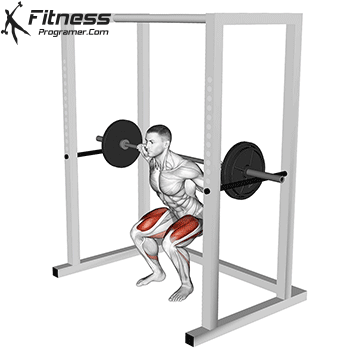
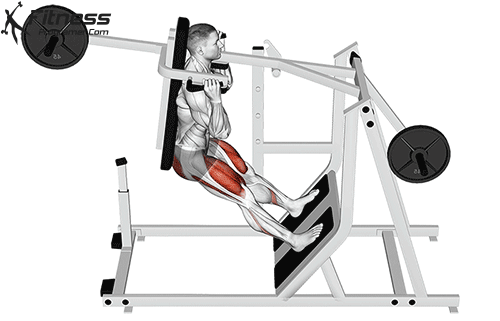

2. Deadlift
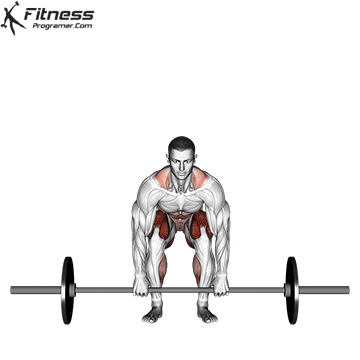
Deadlift is a compound exercise that works the glutes, hamstrings, lower back, traps, lats, and core. It’s one of the most effective full-body lifts for developing posterior chain strength, improving hip hinge mechanics, and enhancing overall athletic power. As a fundamental movement, it is widely used in powerlifting, strength training, hypertrophy, and functional fitness programs.
Recommended repetitions
- For hypertrophy (muscle growth): 3–4 sets of 8–12 reps using moderate to heavy load
- For powerlifting (maximum strength): 4–6 sets of 1–5 reps at high intensity (85–95% 1RM)
- For general strength training: 3–5 sets of 4–6 reps
- For functional or athletic training: 3–4 sets of 6–10 reps, focusing on form, speed, and posterior chain activation
- For endurance or metabolic conditioning: 2–3 sets of 12–20 reps with lighter weights and controlled tempo
Variations:
- Dumbbell deadlift, Trap bar deadlift, Lever deadlift, Sumo deadlift
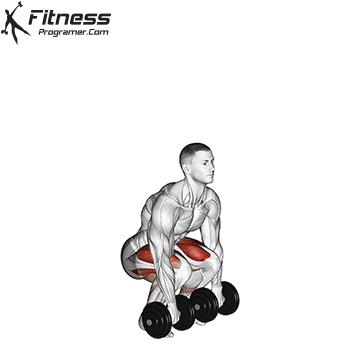
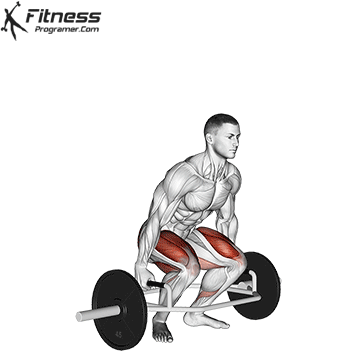
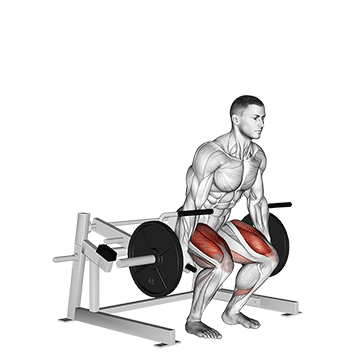

3. Barbell Bench Press
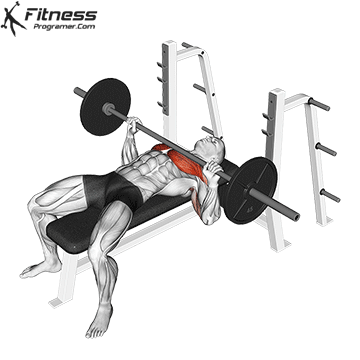
Barbell Bench Press is a compound exercise that works the chest muscles (pectorals) as well as the triceps and anterior (front) deltoids. As a foundational upper body push movement, it is commonly included in strength training, hypertrophy routines, powerlifting, and sports performance programs. It builds upper body mass, pressing strength, and supports improved performance in pushing tasks.
Recommended repetitions
- For hypertrophy (muscle growth): 3–5 sets of 8–12 reps using moderate to heavy weight
- For powerlifting (maximum strength): 4–6 sets of 1–5 reps at high intensity (85–95% 1RM)
- For general strength training: 3–4 sets of 4–6 reps
- For functional training or sport-specific work: 3–4 sets of 6–10 reps, focusing on control and bar path efficiency
- For muscular endurance: 2–3 sets of 12–20 reps with lighter load
Variations:
- Dumbbell press, Incline press, Decline press, Crush press
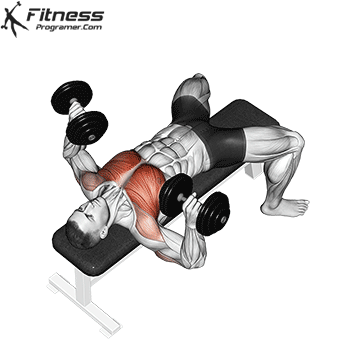
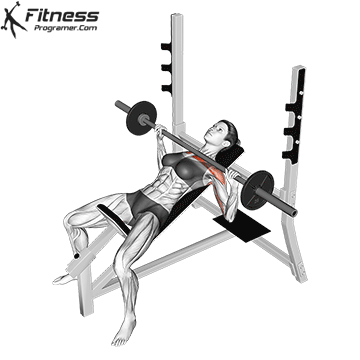
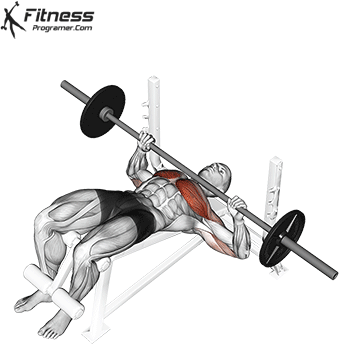
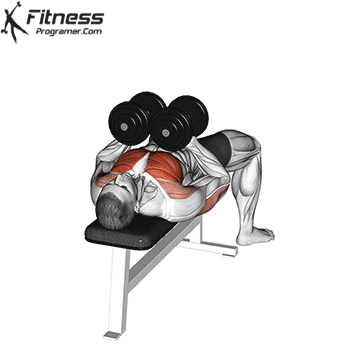
4. Pull-Up (or Assisted Pull-Up)

Pull-Up is a compound upper body exercise that primarily targets the latissimus dorsi (lats), while also engaging the biceps, rear deltoids, rhomboids, traps, and core. It is a bodyweight pulling movement often used in strength training, hypertrophy routines, calisthenics, and functional fitness to improve upper body pulling strength, grip endurance, and postural control. Assisted variations using bands or machines make it accessible for beginners.
Recommended repetitions
- For beginners: 2–3 sets of 5–8 assisted reps, gradually reducing assistance over time
- For hypertrophy (muscle growth): 3–4 sets of 6–12 reps (use assistance if needed to stay in range)
- For strength training: 3–5 sets of 3–6 reps (weighted pull-ups optional)
- For calisthenics or functional training: 3–4 sets of max reps or 6–10 reps with slow tempo
- For muscular endurance: 2–3 sets of 10–20 reps (band-assisted or bodyweight)
Variations:
- Chin-up (more biceps), Commander pull-up, Archer pull-up, Muscle-up
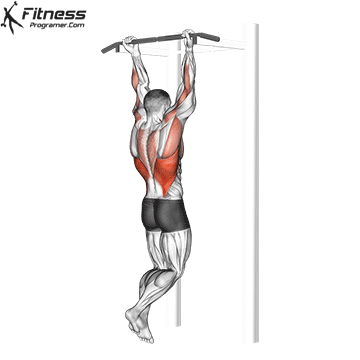
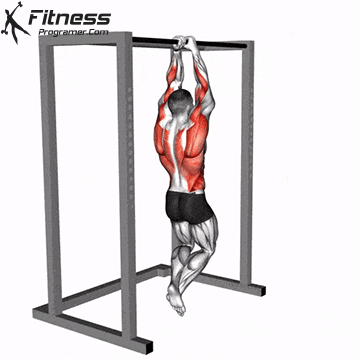
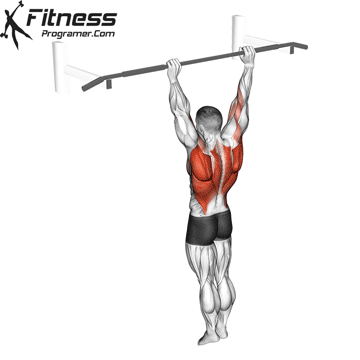
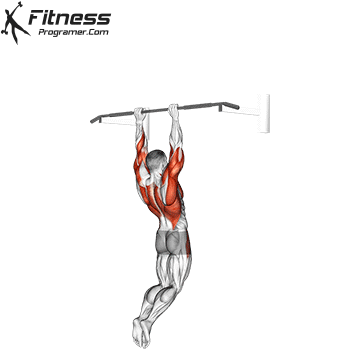
5. Standing Overhead Press
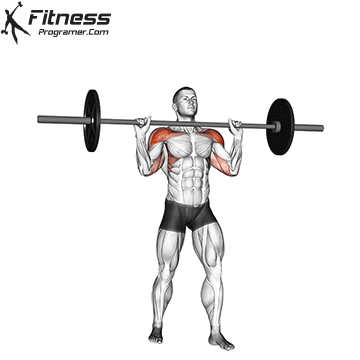
Standing Overhead Press is a compound exercise that targets the shoulders (primarily the anterior and medial deltoids) while also working the triceps, upper chest, trapezius, and core stabilizers. This vertical pressing movement is a key component in strength training, hypertrophy, athletic development, and functional fitness. Because it is performed standing, it also enhances core engagement, postural control, and full-body stability.
Recommended repetitions
- For hypertrophy (muscle growth): 3–5 sets of 8–12 reps using moderate weight
- For strength development: 4–6 sets of 3–6 reps with heavy load
- For athletic or functional training: 3–4 sets of 6–10 reps with focus on full-body control
- For muscular endurance: 2–3 sets of 12–15 reps with lighter weights
- For beginners: 2–3 sets of 8–10 reps, emphasizing form and shoulder mobility
Variations:
- Seated shoulder press, Kettlebell press, Alternating dumbbell press, Smith machine overhead press
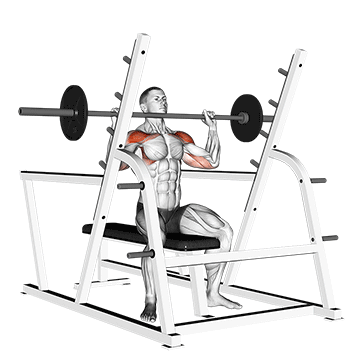
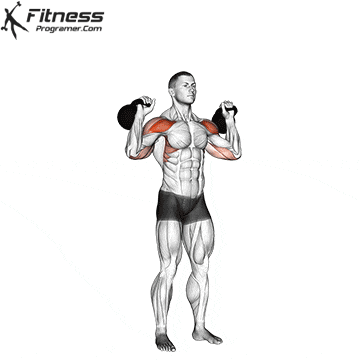
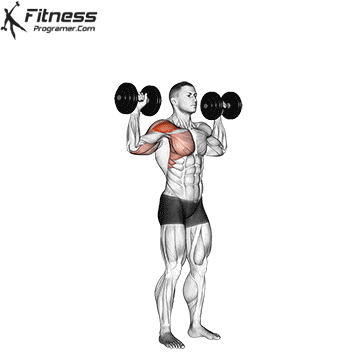
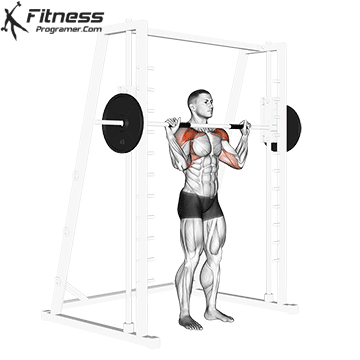
6. Barbell Bent-Over Row
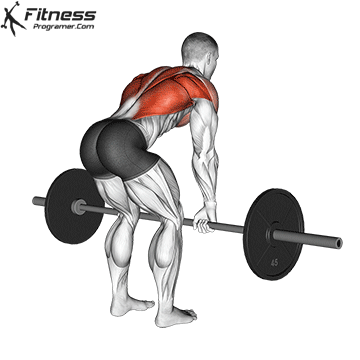
Barbell Bent-Over Row is a compound pulling exercise that primarily targets the latissimus dorsi, rhomboids, rear deltoids, traps, and spinal erectors, while also engaging the biceps and core. It is widely used in strength training, bodybuilding (hypertrophy), powerlifting assistance work, and functional fitness to build a strong, thick back and improve postural support and horizontal pulling strength.
Recommended repetitions
- For beginners: 2–3 sets of 8–10 reps, emphasizing proper hip hinge and back position
- For hypertrophy (muscle growth): 3–4 sets of 8–12 reps using moderate to heavy weight
- For strength training: 3–5 sets of 4–6 reps with controlled tempo and heavier loads
- For athletic or functional performance: 3–4 sets of 6–10 reps, focusing on form and back engagement
- For muscular endurance: 2–3 sets of 12–15 reps with lighter load and strict form
Variations:
- Pendlay row, T-bar row, Dumbbell row, Smith machine row
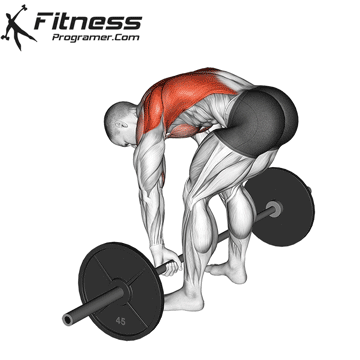
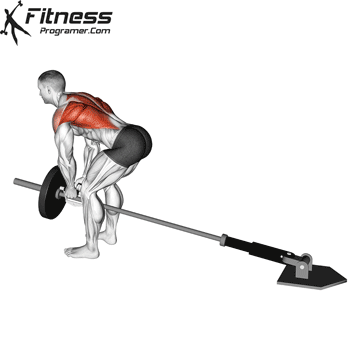
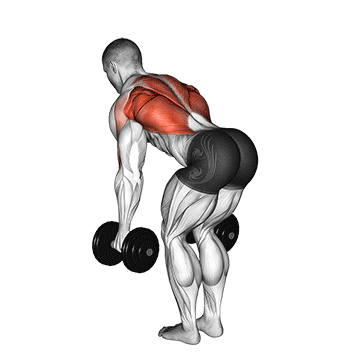
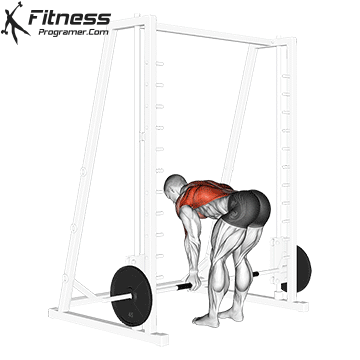
7. Front Squat

Front Squat is a compound lower-body exercise that targets the quadriceps more directly than the back squat, while also engaging the glutes, hamstrings, core, and upper back. Holding the barbell in the front rack position emphasizes torso uprightness and core activation, making it a valuable addition to strength training, hypertrophy routines, Olympic weightlifting, and functional fitness programs. It also helps improve mobility, posture, and athletic movement patterns.
Recommended repetitions
- For beginners: 2–3 sets of 6–10 reps, practicing bar position and depth control
- For hypertrophy (muscle growth): 3–4 sets of 8–12 reps with moderate load
- For strength training: 4–5 sets of 3–6 reps with heavier weight and proper bracing
- For functional or athletic training: 3–4 sets of 6–10 reps, focusing on control and mobility
- For muscular endurance or conditioning: 2–3 sets of 12–15 reps with lighter load
Variations:
- Goblet squat, plie squat, Kettlebell squat, Sumo squat
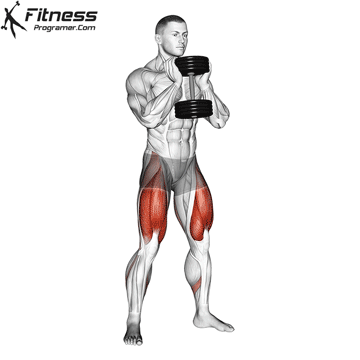
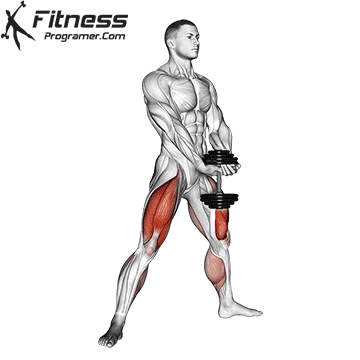
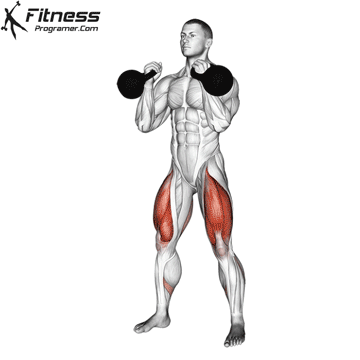
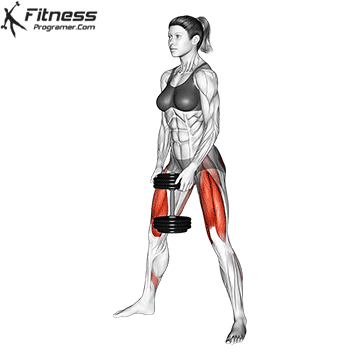
8. Romanian Deadlift
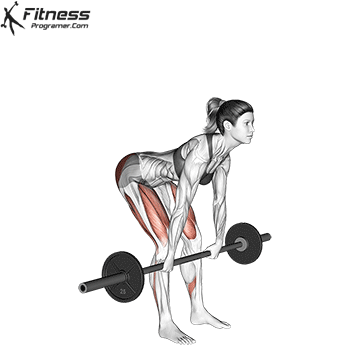
Romanian Deadlift (RDL) is a compound hinge movement that primarily targets the hamstrings and glutes, while also engaging the lower back, adductors, and core. Unlike the conventional deadlift, the RDL emphasizes eccentric control and a deeper stretch in the posterior chain. It’s commonly used in hypertrophy training, strength development, athletic conditioning, and rehabilitative programs to improve hamstring strength, hip mobility, and injury prevention.
Recommended repetitions
- For beginners: 2–3 sets of 8–10 reps, focusing on hip hinge form and range of motion
- For hypertrophy (muscle growth): 3–4 sets of 8–12 reps with a focus on tempo and stretch
- For strength training: 3–5 sets of 5–8 reps using moderate to heavy loads
- For functional or athletic performance: 3–4 sets of 6–10 reps emphasizing hip hinge mechanics
- For endurance or corrective work: 2–3 sets of 12–15 reps with lighter weight and slow tempo
Variations:
- Dumbbell RDL, Single leg deadlift, DB stiff leg deadlift, Barbell stiff leg deadlift
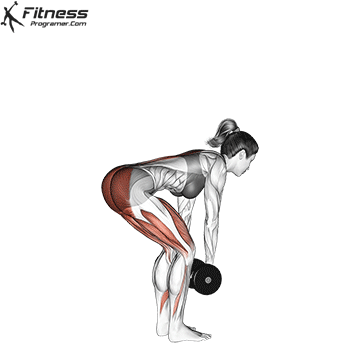


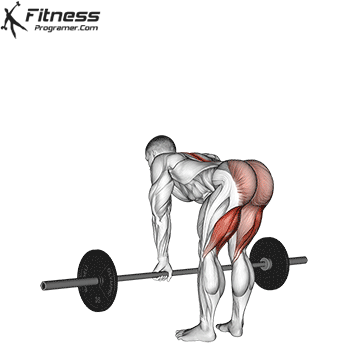
9. Walking Lunge

Walking Lunge is a compound lower-body exercise that works the quadriceps, glutes, hamstrings, and calves, while also engaging the core and improving balance, coordination, and hip mobility. Unlike stationary lunges, the walking variation adds a dynamic element, making it a staple in hypertrophy routines, functional training, athletic development, and conditioning circuits. It also helps correct muscle imbalances between legs.
Recommended repetitions
- For beginners: 2–3 sets of 6–10 steps per leg, starting with bodyweight or light dumbbells
- For hypertrophy (muscle growth): 3–4 sets of 8–12 steps per leg with moderate load
- For strength training: 3–5 sets of 6–8 steps per leg using heavy dumbbells or barbell
- For functional or athletic training: 3–4 sets of 10–12 steps per leg, focusing on stride and control
- For muscular endurance or conditioning: 2–3 sets of 12–20 steps per leg with lighter load or bodyweight
Variations:
- Static, lunge, Power lunge, Reverse lunge, Curtsey lunge
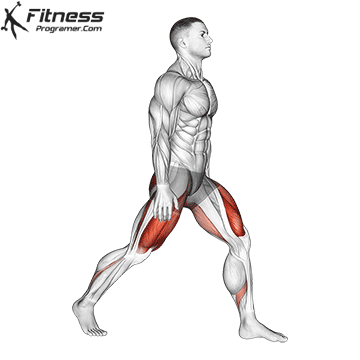

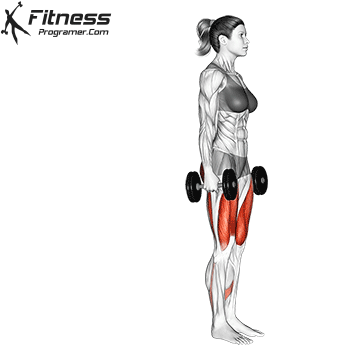
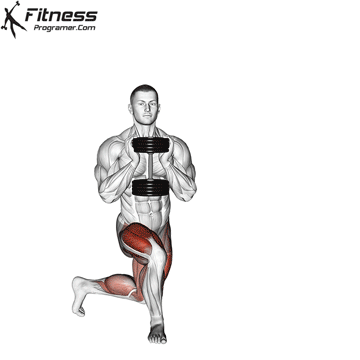
10. Kettlebell Swing
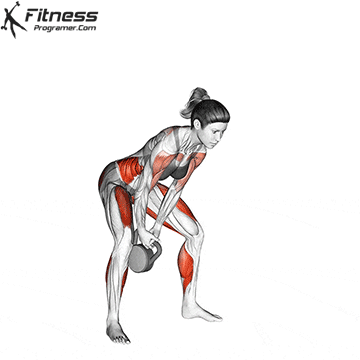
Kettlebell Swing is a dynamic compound exercise that targets the glutes, hamstrings, hips, and core, while also activating the lats, shoulders, and grip. It is a ballistic hip hinge movement that builds explosive power, muscular endurance, and cardiovascular conditioning. Commonly used in functional training, fat-loss circuits, athletic development, and conditioning programs, the kettlebell swing improves hip drive, posture, and total-body coordination.
Recommended repetitions
- For beginners: 2–3 sets of 10–15 swings, focusing on hip hinge mechanics and control
- For power and athletic performance: 3–5 sets of 10–15 swings focusing on explosive hip extension
- For hypertrophy (as a posterior chain finisher): 3–4 sets of 12–20 swings with moderate weight
- For metabolic conditioning or fat loss: 3–5 sets of 15–30 swings, possibly combined into circuits
- For endurance: 2–3 sets of 30–50 swings with light to moderate weight and sustained pace
Variations:
- One Arm Kettlebell Swing, One Arm Kettlebell Snatch, Kettlebell Clean and Jerk, Kettlebell hang clean
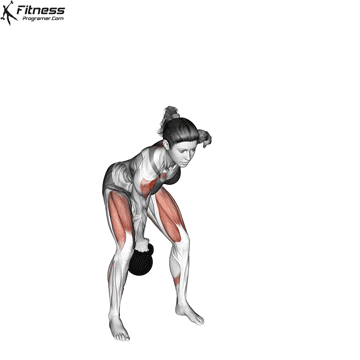

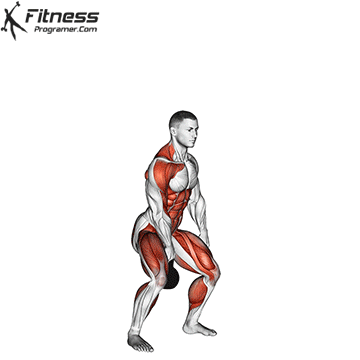
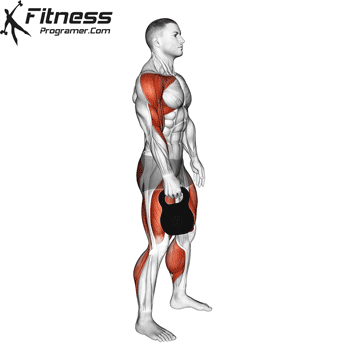
11. Thruster
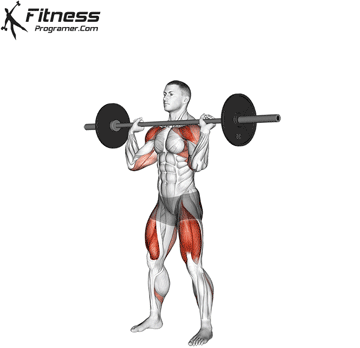
Thruster is a powerful compound movement that combines a front squat with an overhead press, working the quadriceps, glutes, shoulders, triceps, core, and upper back. It is a full-body exercise that enhances strength, coordination, and metabolic conditioning, making it a staple in CrossFit, HIIT, functional fitness, and athletic performance programs. The thruster develops explosive power, improves movement efficiency, and elevates heart rate quickly for fat-burning results.
Recommended repetitions
- For beginners: 2–3 sets of 6–10 reps, starting with light dumbbells or kettlebells to learn movement mechanics
- For metabolic conditioning or fat loss: 3–5 sets of 10–20 reps, often used in timed circuits or AMRAPs
- For hypertrophy: 3–4 sets of 8–12 reps using moderate weight and steady tempo
- For functional fitness or CrossFit: 3–5 sets of 10–15 reps, focusing on fluidity and speed under fatigue
- For strength-endurance: 2–3 sets of 12–20 reps with moderate load
Variations:
- Kettlebell thruster, Overhead squat, Heaving snatch balance, Landmine squat to press
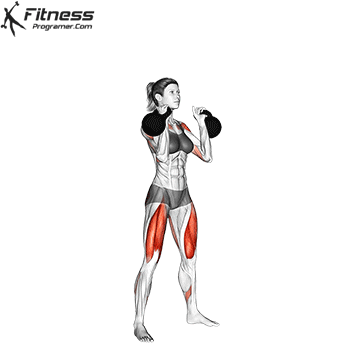
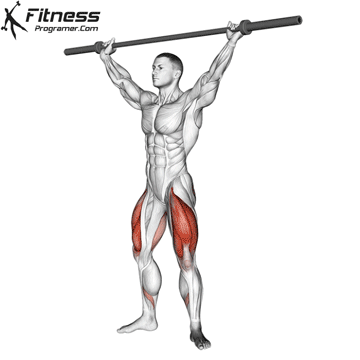
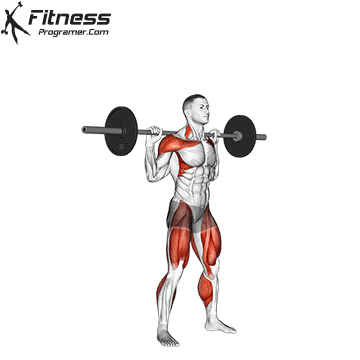
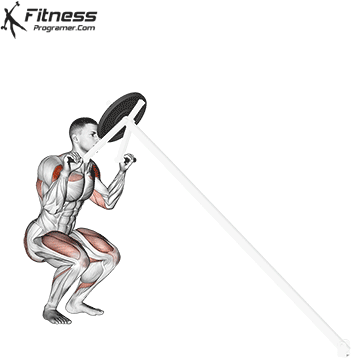
12. Clean and Press
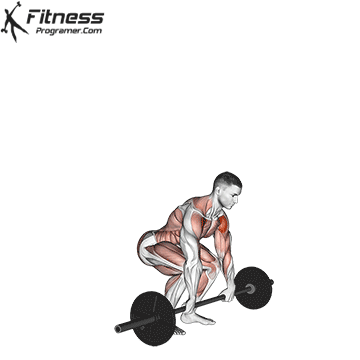
Clean and Press is a full-body compound exercise that combines two powerful movements: the clean, which involves lifting a weight from the floor to the shoulders, and the overhead press, which drives the weight overhead. It primarily works the glutes, hamstrings, quadriceps, traps, deltoids, triceps, and core. This exercise is widely used in Olympic weightlifting, strength and power training, CrossFit, and functional fitness to build explosiveness, coordination, and total-body strength.
Recommended repetitions
- For beginners: 2–3 sets of 4–6 reps using dumbbells or kettlebells to learn safe mechanics
- For functional fitness or conditioning: 3–5 sets of 8–12 reps in circuits or complexes
- For power and athletic performance: 4–5 sets of 3–5 reps with moderate to heavy weight, focusing on speed and technique
- For muscular endurance: 2–3 sets of 12–15 reps with lighter weight and high tempo
Variations:
- Dumbbell clean and press, kettlebell version
13. Push-Up
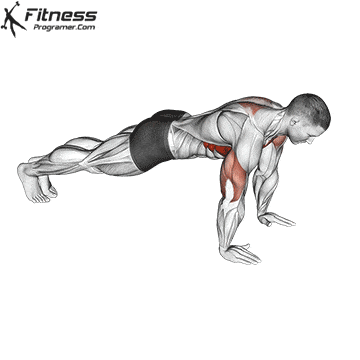
Push-Up is a classic compound bodyweight exercise that primarily targets the chest (pectorals), triceps, and anterior deltoids, while also engaging the core, serratus anterior, and glutes to maintain full-body tension. It’s widely used in strength training, hypertrophy routines, functional fitness, and bodyweight conditioning. Because it requires no equipment, the push-up is accessible to all levels and helps build upper-body pressing strength, stability, and muscular endurance.
Recommended repetitions
- For beginners: 2–3 sets of 6–10 reps from knees or elevated surface (incline push-up) to build form and control
- For hypertrophy: 3–4 sets of 8–15 reps (use variations or tempo for added difficulty)
- For strength development: 3–5 sets of 5–10 reps (weighted push-ups or advanced variations like archer push-ups)
- For muscular endurance or conditioning: 2–3 sets of 15–25+ reps with short rest periods
- For functional fitness: 3–4 sets of 10–20 reps, possibly paired with core or pulling movements
- Variations:
Incline push-up, Decline push-Up, Bosu ball push-Up, Archer push-up
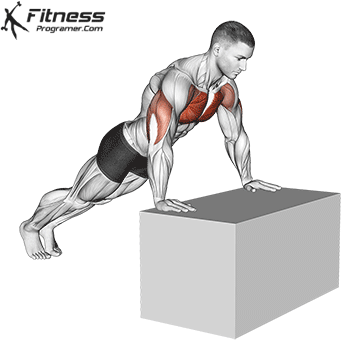
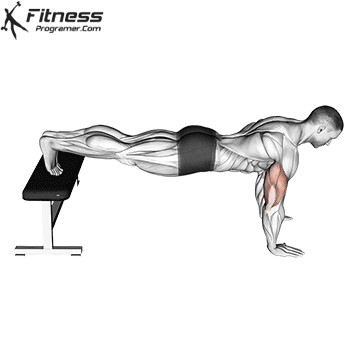
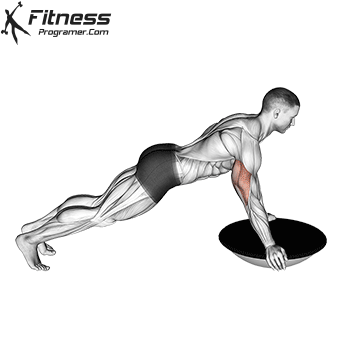

14. Parallel Bar Dips
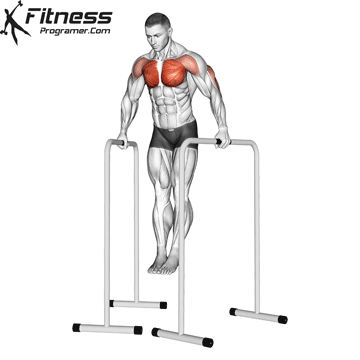
Parallel Bar Dips are a bodyweight compound pushing exercise that primarily targets the triceps, chest (especially the lower portion), and anterior deltoids, while also engaging the core and scapular stabilizers. Depending on torso angle, dips can emphasize either triceps (upright posture) or chest (forward lean). This exercise is commonly used in strength training, hypertrophy routines, calisthenics, and gymnastics-based programs to build upper-body pressing strength and muscular control.
Recommended repetitions
- For beginners: 2–3 sets of 6–10 reps using assistance bands or dip machine support
- For hypertrophy: 3–4 sets of 8–12 reps (use added weight if needed)
- For strength training: 3–5 sets of 4–6 reps with weighted dips or advanced variations
- For muscular endurance: 2–3 sets of 12–20+ reps with bodyweight
- For functional or calisthenics training: 3–4 sets of 6–15 reps, emphasizing range of motion and shoulder stability
Variations:
- Bench Dips, Triceps dips, Chest dips, Korean dips
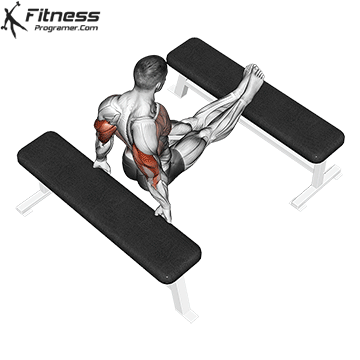
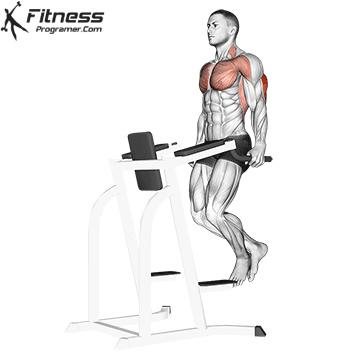
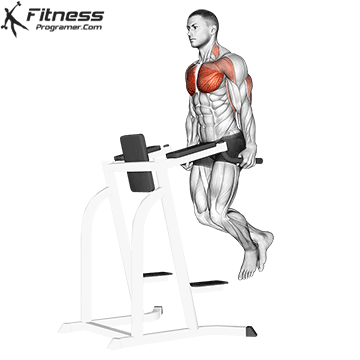
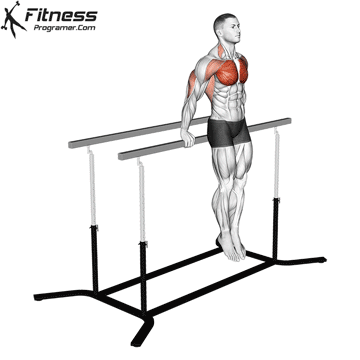
15. Farmer’s Carry
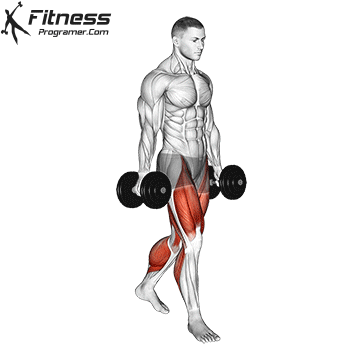
Farmer’s Carry is a full-body compound loaded carry exercise that primarily targets the grip, forearms, traps, shoulders, core, and glutes, while also engaging the legs for stabilization. It builds functional strength, improves postural control, and enhances core endurance and grip capacity. This movement is a staple in strongman training, athletic performance, functional fitness, and fat-loss circuits, known for training real-world strength and stability under load.
Recommended repetitions / duration
- For beginners: 2–3 sets of 15–30 meters or 20–30 seconds using light to moderate weights with upright posture
- For grip and trap hypertrophy: 3–4 sets of 30–40 seconds with heavy dumbbells, kettlebells, or farmer handles
- For strength and power: 4–5 sets of 20–30 meters carrying near-maximal load
- For conditioning and fat loss: 3–5 sets of 40–60 seconds walk with moderate weight, minimal rest
- For functional training: 3–4 sets of 20–40 meters, focusing on posture and core engagement
16. Zercher Carry
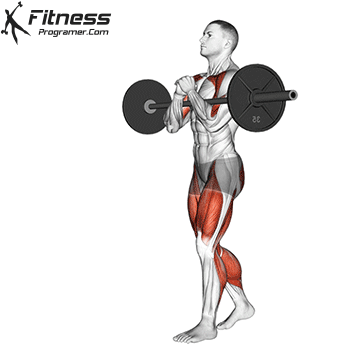
Zercher Carry is a loaded carry variation where the weight is held in the crook of the elbows, emphasizing the core, upper back, glutes, hamstrings, and quadriceps, while also challenging biceps and forearm endurance. This compound movement builds midline stability, postural strength, and full-body bracing, making it popular in strongman training, functional strength programs, and athletic conditioning. The Zercher position mimics real-life odd object carrying and improves anti-flexion control.
Recommended repetitions / distance
- For beginners: 2–3 sets of 10–20 meters or 20–30 seconds with light to moderate load, focusing on form
- For core and postural strength: 3–4 sets of 20–30 meters or 30–45 seconds with moderate to heavy load
- For strength training: 3–5 sets of 15–25 meters using a heavy sandbag, barbell, or loaded implement
- For functional fitness: 3–4 sets of 20–40 meters focusing on upright posture and controlled breathing
- For conditioning circuits: 2–3 sets of 30–60 seconds as part of a metabolic finisher
17. Push Press
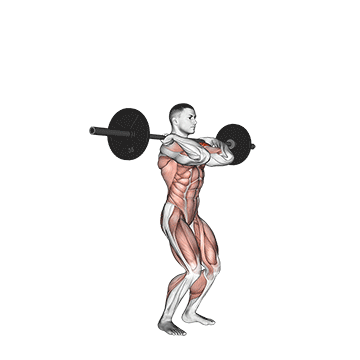
Push Press is a powerful compound movement that combines a partial leg drive with an overhead press, targeting the shoulders (deltoids), triceps, upper chest, and core, while also engaging the glutes, quads, and hamstrings to initiate the movement. It allows for heavier loading than a strict press by utilizing hip and knee extension. Common in Olympic weightlifting, CrossFit, strength, and power training, the push press builds explosiveness, upper-body strength, and athletic coordination.
Recommended repetitions
- For beginners: 2–3 sets of 5–8 reps, emphasizing dip-drive timing and overhead control
- For power and athletic development: 3–5 sets of 3–5 reps with explosive intent and moderate to heavy load
- For hypertrophy: 3–4 sets of 6–10 reps, focusing on shoulder drive and time under tension
- For strength training: 3–5 sets of 4–6 reps with progressively heavier weights
- For functional fitness or conditioning: 3–4 sets of 8–12 reps, often paired with other compound lifts in circuits
18. Log Lift
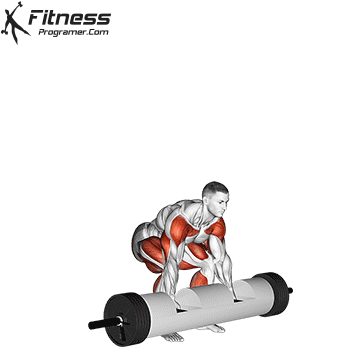
Log Lift is a strongman-style compound exercise that involves cleaning a log from the ground to the shoulders and pressing it overhead. It primarily targets the shoulders, triceps, upper chest, and upper back, while also engaging the glutes, hamstrings, quads, core, and grip. The neutral-hand position and thick diameter of the log add a unique challenge, making it excellent for building functional upper-body strength, pressing power, and real-world lifting capacity. It is a staple in strongman competitions, but also valuable in power, strength, and athletic training.
Recommended repetitions
- For beginners: 2–3 sets of 4–6 reps using a light log or log-shaped implement to practice safe mechanics
- For strength and power development: 3–5 sets of 3–5 reps with heavy loads and full-body explosiveness
- For hypertrophy (upper body focus): 3–4 sets of 6–10 reps with moderate load, controlling both clean and press phases
- For strongman or sport-specific training: 4–6 sets of 1–3 heavy reps with strict or push press variations
- For functional training: 3–4 sets of 4–8 reps, emphasizing form, coordination, and overhead lockout
Other Olympic Variations: Barbell snatch, Power snatch, Muscle snatch, Kettlebell split snatch
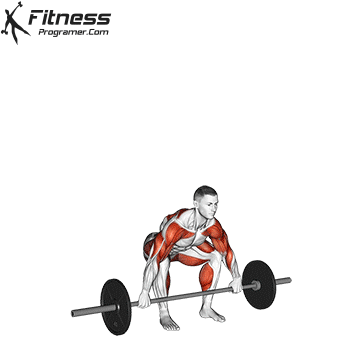
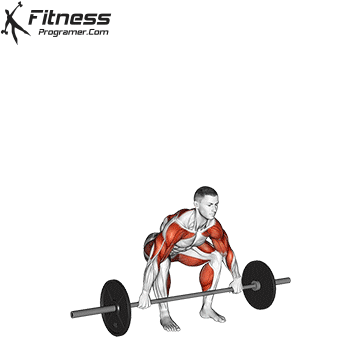
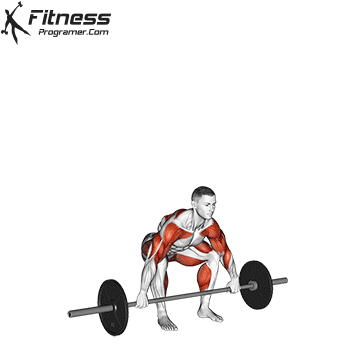
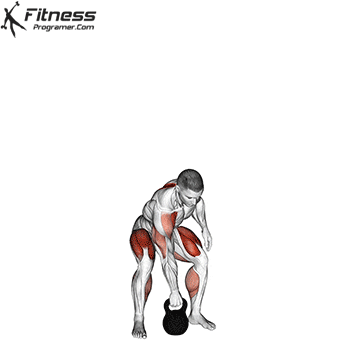
19. Rowing Machine
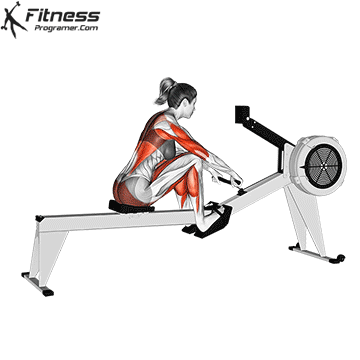
Rowing Machine is a full-body, compound cardiovascular exercise that mimics the motion of rowing a boat. It primarily works the back muscles (lats, rhomboids, traps), hamstrings, glutes, calves, and core, while also engaging the biceps and forearms during the pulling phase. Unlike many cardio machines, rowing emphasizes posterior chain development, making it valuable in conditioning, fat-loss, functional training, and endurance programs. It builds aerobic capacity, muscular endurance, and reinforces synchronous movement patterns.
Recommended repetitions / duration
- For beginners: 2–3 sets of 250 meters at easy pace, focusing on drive mechanics and posture
- For conditioning and fat loss: 3–5 rounds of 250–500 meters or 1–3 minutes at moderate to high intensity
- For endurance training: 20–40 minutes of steady-state rowing at 60–70% max effort
- For high-intensity interval training (HIIT): 5–10 intervals of 30 seconds max effort / 60 seconds rest
- For functional circuits: 200–500 meters between strength exercises, 3–4 rounds total
20. Dumbbell Burpees
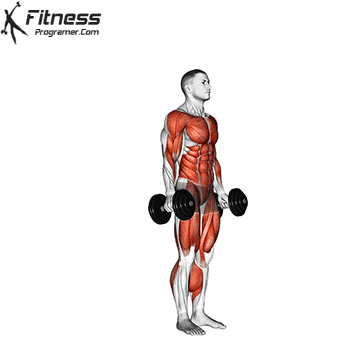
Dumbbell Burpees are a dynamic, full-body compound exercise that combines a squat thrust, push-up, and dumbbell deadlift or snatch into one high-intensity movement. This variation primarily targets the chest, shoulders, triceps, quads, glutes, hamstrings, and core, while also improving cardiovascular conditioning and explosive power. Dumbbell burpees are popular in CrossFit, HIIT, functional fitness, and fat-loss programs, offering a challenging blend of strength, endurance, and metabolic conditioning.
Recommended repetitions
- For beginners: 2–3 sets of 6–8 reps using lighter dumbbells and stepping through the movement to reduce impact
- For conditioning and fat loss: 3–5 sets of 8–15 reps with moderate dumbbells and minimal rest
- For high-intensity interval training (HIIT): 20–30 seconds of max-effort burpees followed by 30–40 seconds rest, 4–6 rounds
- For functional fitness: 3–4 sets of 6–12 reps, optionally paired with squats, lunges, or rows
- For muscular endurance: 2–3 sets of 12–20 reps with light dumbbells and steady pacing
Variations: Bodyweight burpees, Jack burpees, Navy seal burpee, Dumbbell devil press
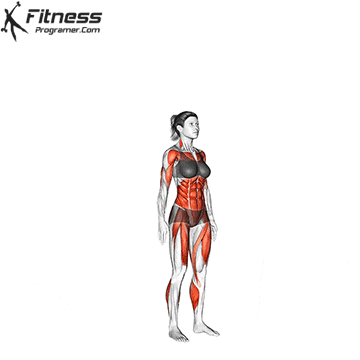
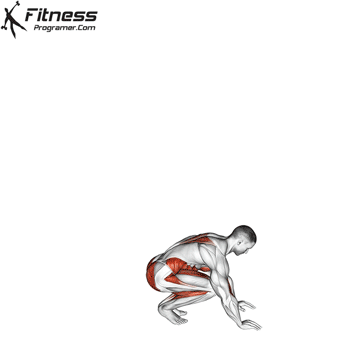
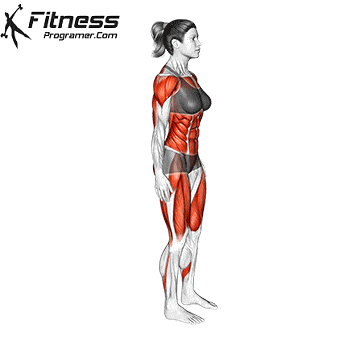
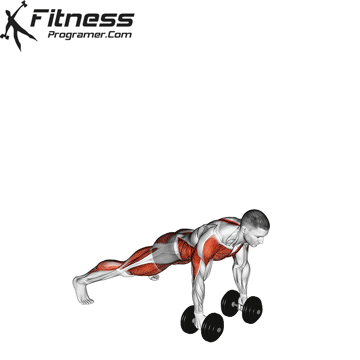
21. Turkish Get-up
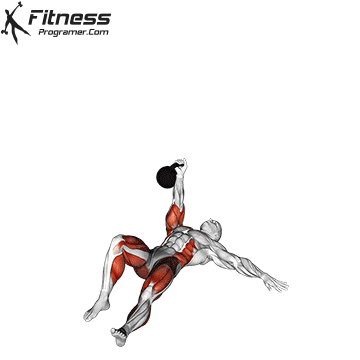
Turkish Get-Up is a slow, controlled full-body compound exercise that involves transitioning from lying on the floor to a standing position while holding a weight overhead. It works nearly every major muscle group, including the shoulders, triceps, core, glutes, hamstrings, quads, and upper back, while also demanding joint stability, mobility, and neuromuscular control. It’s a staple in functional training, mobility programs, kettlebell routines, and rehabilitative strength work, enhancing body awareness, coordination, and movement quality.
Recommended repetitions
- For beginners: 2–3 sets of bodyweight or shoe-balance reps to learn technique before adding load
- For core control and shoulder health: 2–3 sets of 2–5 reps per side using light to moderate load
- For strength and stability: 3–4 sets of 2–4 reps per side with a moderate to heavy kettlebell or dumbbell
- For functional training and mobility: 3–5 sets of 1–3 slow, controlled reps per side, focusing on form and transitions
- For conditioning (advanced athletes): 4–6 rounds of alternating reps for time, using a moderate load
22. Wall Ball
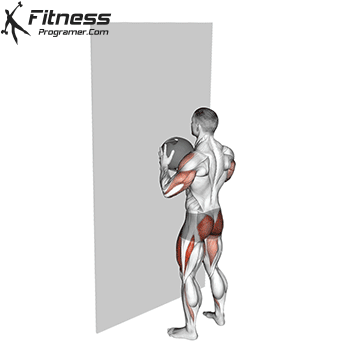
Wall Ball is a high-intensity, full-body compound exercise that involves performing a front squat followed by an explosive overhead throw of a medicine ball to a target on the wall. It primarily targets the quads, glutes, hamstrings, shoulders, chest, and core, while also training explosiveness, coordination, and cardiovascular endurance. Wall balls are a cornerstone of CrossFit, HIIT circuits, and metabolic conditioning workouts, offering both muscular and aerobic challenges in a single movement.
Recommended repetitions
- For beginners: 2–3 sets of 6–10 reps using a light ball, ensuring proper squat form and controlled throws
- For conditioning and fat loss: 3–5 sets of 15–25 reps using a moderate-weight ball with minimal rest
- For muscular endurance: 2–3 sets of 20–30 reps focusing on consistent pace and depth
- For functional fitness or CrossFit WODs: AMRAP (as many reps as possible) in 60–90 seconds or for rounds (e.g., 21-15-9 format)
- For power development: 3–4 sets of 8–12 reps with a heavier ball and focus on speed during the throw
23. Dumbbell Iron Cross
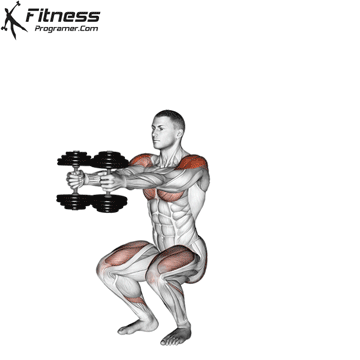
Dumbbell Iron Cross is a standing, full-body compound movement that challenges shoulder stability, core strength, and postural control. Holding a dumbbell in each hand with arms extended in a “T” position at shoulder height, this exercise primarily targets the deltoids, traps, upper back, and core, while engaging the glutes, legs, and grip for stability. It is used in functional training, core conditioning, and rotator cuff strengthening, promoting shoulder endurance, postural integrity, and isometric control.
Recommended repetitions
- For beginners: 2–3 sets of 10–20 seconds hold with light weights or bodyweight, emphasizing shoulder alignment
- For shoulder and core endurance: 3–4 sets of 20–40 seconds hold with light dumbbells
- For functional strength and posture: 3–4 sets of 8–12 reps (dynamic raises or controlled walk)
- For mobility and stability: 2–3 sets of 10–15 reps with slow tempo and focus on scapular positioning
24. Battle Rope
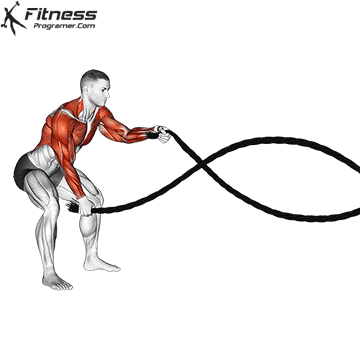
Battle Rope exercises are high-intensity, compound movements that combine upper-body power, core stability, and lower-body engagement. Movements such as alternating waves, slams, or circles primarily work the shoulders, arms (biceps and triceps), upper back, and core, while also involving the legs and glutes for grounding and movement. Popular in HIIT, functional training, and athletic conditioning, battle ropes build muscular endurance, explosiveness, and metabolic conditioning.
Recommended repetitions / duration
- For beginners: 2–3 sets of 15–20 seconds using alternating waves at moderate speed and focus on posture
- For conditioning and fat loss: 4–6 rounds of 20–30 seconds max-effort waves or slams with 30–60 seconds rest
- For muscular endurance: 3–5 sets of 30–60 seconds of continuous waves or timed circuits
- For power development: 3–4 sets of 10–15 explosive slams with full-body force
- For functional training circuits: 3–4 rounds of 15–20 seconds as part of a metabolic finisher
25. Backward Medicine Ball Throw
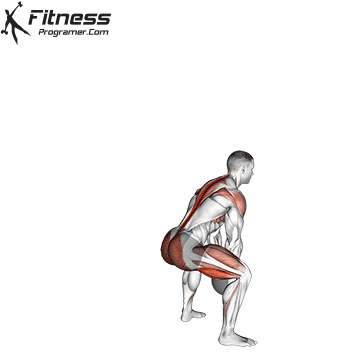
Backward Medicine Ball Throw is an explosive, full-body compound movement that emphasizes hip extension, posterior chain strength, and power output. It primarily targets the glutes, hamstrings, lower back, and shoulders, while also engaging the core to stabilize the spine and transfer force. This athletic movement is used in power development, sports performance, and functional training to enhance triple extension and explosive hip drive—key components in sprinting, jumping, and lifting.
Recommended repetitions
- For beginners: 2–3 sets of 4–6 reps using a light ball, focusing on technique and coordination before adding power
- For power and athletic performance: 4–6 sets of 3–5 explosive throws with maximal intent and full rest between sets
- For strength-speed development: 3–5 sets of 5–8 reps using a moderate-weight ball with focus on hip drive
- For functional training: 3–4 rounds of 5–10 reps as part of a power-focused circuit
Other Variations: Med ball rotational throw, One Arm med ball slam, Med ball half kneeling chest push, Step behind rotational med ball throw

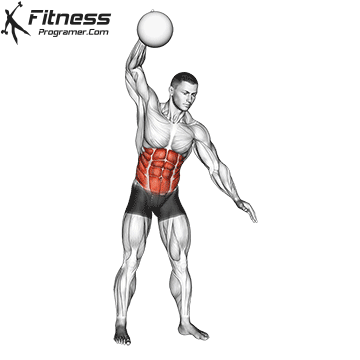
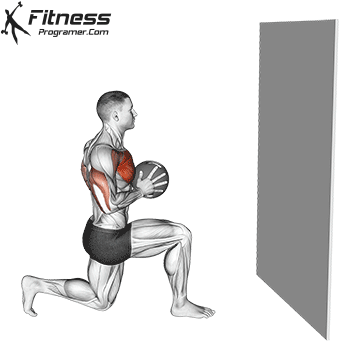
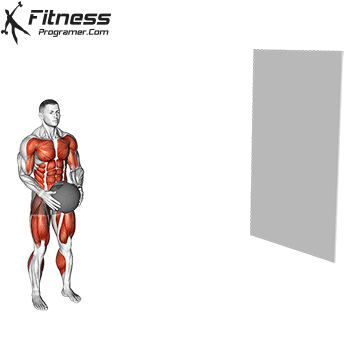
Programming Guidance
It’s one thing to know which compound exercises exist—but knowing how to structure them is key to making real progress. Your routine should be based on your training goal, experience level, and available equipment.
Here’s how you can organize compound exercises into an effective program:
1. Choose a Split or Format
Select a training split that fits your schedule and recovery ability:
- Full-body (3x/week): 3–5 compound exercises per session (For example: 3-day compound workout)
- Upper/Lower Split (4x/week): Alternate between upper- and lower-body compound lifts
- Push/Pull/Legs (3–6x/week): Group similar movement patterns (e.g., squats, hinges, presses)
- Strength + Conditioning Hybrid: Alternate strength days (heavy compound lifts) with metabolic circuits (sample routine: 3×5 strength training for beginners)
For Hypertrophy: Combine Compound and Isolation Exercises
To build muscle effectively, it’s important to include both compound and isolation exercises in your workout routine. Compound movements stimulate large amounts of muscle mass and allow you to lift heavier, while isolation exercises target specific muscles for detailed development and muscular symmetry.
Here’s how a balanced hypertrophy workout might look for different muscle groups:
Chest
- Barbell Bench Press (compound) – Works chest, shoulders, triceps
- Incline Dumbbell Press (compound) – Emphasizes upper chest and front delts
- Dumbbell Flys (isolation) – Isolates the chest for a deep stretch and peak contraction
Legs
- Squats (compound) – Targets quads, glutes, hamstrings, and core
- Leg Press (isolation) – Focuses on the quads with reduced core involvement
- Leg Extensions (isolation) – Isolates the quadriceps
Back
- Pull-Ups (compound) – Works lats, biceps, and upper back
- Lat Pull-Downs (compound) – Similar to pull-ups, scalable resistance
- Straight Arm Lat Pull-Downs (isolation) – Targets the lats with minimal arm involvement
Shoulders
- Military Press (compound) – Hits front delts, upper chest, and triceps
- Lateral Raises (isolation) – Focuses on the side delts for width
- Rear Delt Flys (isolation) – Isolates the rear delts for balanced shoulder development
Tip: Start your workouts with compound lifts when your energy and strength are highest. Follow with isolation exercises to maximize muscle fatigue and growth. Finish with conditioning or core work if desired
2. Match Sets and Reps to Your Goal
| Goal | Reps | Sets | Rest | Notes |
|---|---|---|---|---|
| Strength | 3–6 reps | 3–6 | 2–5 min | Focus on barbell lifts, lower volume, higher weight |
| Hypertrophy | 6–12 reps | 3–5 | 60–90 sec | Moderate weights, higher volume for growth |
| Endurance | 12–20+ reps | 2–4 | 30–60 sec | Bodyweight, dumbbell circuits |
| Power/Explosive | 1–5 reps | 3–6 | 2–3 min | Use cleans, swings, jumps, throws |
| Fat Loss / HIIT | Timed sets | 3–6 rounds | Short rests | Compound movements in circuits or intervals |
3. Use Progression
Track your lifts and gradually increase load, volume, or movement complexity over time. Example:
- Week 1–2: Goblet Squat →
- Week 3–4: Front Squat →
- Week 5+: Barbell Back Squat
4. Balance Movement Patterns
Ensure your plan covers all key movement patterns to prevent imbalances:
- Push (bench press, push-up, overhead press)
- Pull (row, pull-up, deadlift)
- Squat (back squat, goblet squat, lunge)
- Hinge (deadlift, RDL, kettlebell swing)
- Carry/Core (farmer’s carry, Turkish get-up, plank variations)
Conclusion
Compound exercises are the foundation of any effective training program, offering unmatched efficiency and results. By incorporating a variety of compound lifts into your routine, you’ll train smarter—not just harder. You’ll improve coordination, increase your metabolism, and build a body that’s not only stronger, but more functional and resilient.
References
- Schoenfeld, B. J. (2010). The mechanisms of muscle hypertrophy and their application to resistance training. Journal of Strength and Conditioning Research, 24(10), 2857–2872. https://doi.org/10.1519/JSC.0b013e3181e840f3
- Król, H., & Piech, K. (2020). The impact of multi-joint and single-joint strength exercises on physical performance. Journal of Human Kinetics, 72, 49–58.
- American College of Sports Medicine. (2021). ACSM’s Guidelines for Exercise Testing and Prescription (11th ed.).
- Schoenfeld, B. J., & Grgic, J. (2018). Evidence-based guidelines for resistance training volume to maximize hypertrophy. Strength and Conditioning Journal, 40(4), 107–112.



